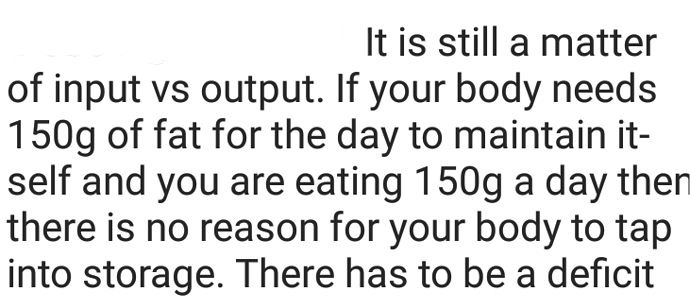I ran across this comment today and I was wondering how accurate it was. The logic seems to be different from what I’ve learned thus far.
If it is true, how does one figure out what “maintenance mode” is? Perhaps this is something that people have to track meticulously to find?
Is this accurate?
It really comes down to your own body. Some can eat unlimited fat and still drop weight. I, personally, now that I am fat adapted, need to watch my fat intake along with my protein otherwise I stall.
The hard truth is as long as you stay with in keto guidelines, it takes a lot of experimentation with your own body to find that sweet spot!
The real problem is that a deficit is basically impossible to gauge. Food labels are allowed to be pretty inaccurate, it’s hard to judge how much energy an individual will actually extract from a given food, and calorie burn is a moving target that varies with calorie inputs.
So interesting.
I’ve lost around 40 lbs since January and recently noticed my weight loss has slowed down tremendously. To a halt. I cut out bulletproof coffees and just drink black (as of today). I’m hoping this change will turn things around for me.
For people with insulin resistance? Not accurate.
Because this assumes you have 100% access to your body fat, which if you have high insulin is not true.
@brenda found that when she increased fat she lost inches.
When I lowered protein and increased fat I started losing again… .5 pounds a day (probably close to the maximum for me).
For some this may be something they need to do OR something they can do without it backfiring but for people with metabolic disorders, no it does not work like that and only results in a slowed metabolism.
I don’t put an upper limit on fat intake and don’t have much left to lose, but still dropped another 2.5lbs in the last two weeks (and an inch off my waist).
Exactly right.
Also body fat switches between releasing energy or storing it based on a signal from Insulin. When Insulin is high body fat gets a signal to store energy, when low it releases it.
If your insulin is low and you have plenty of body fat then you will have a lot of energy in circulation and you may be full already before you have eaten all that 150g of fat.
If your insulin is too high then you won’t be able to draw energy from body fat, and if you eat less than your body needs then your metabolic rate will slow, you will become more hungry, and you will burn protein to supplement your energy shortfall.
For some people a ketogenic diet lowers their insulin enough to join that first group. For others it gets them closer than they were on the SAD diet, and over time on a ketogenic diet they may get even closer.

